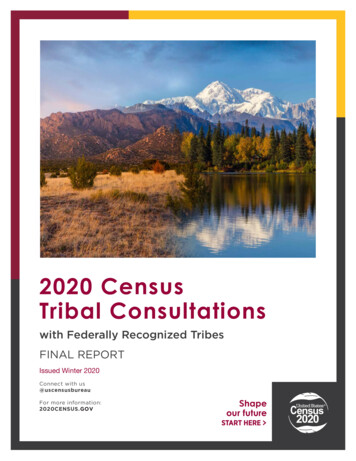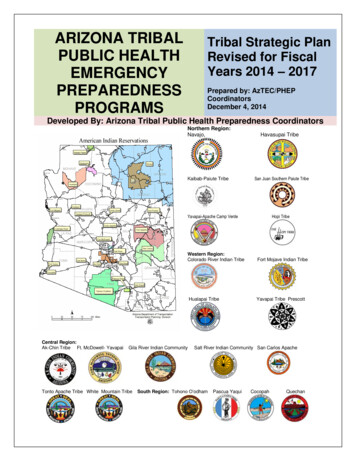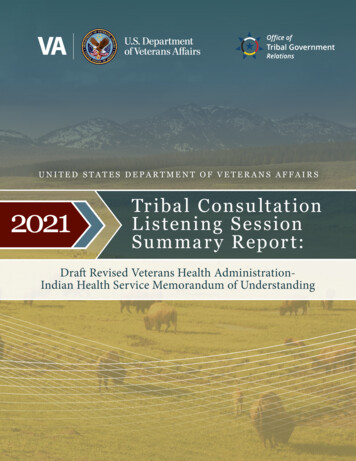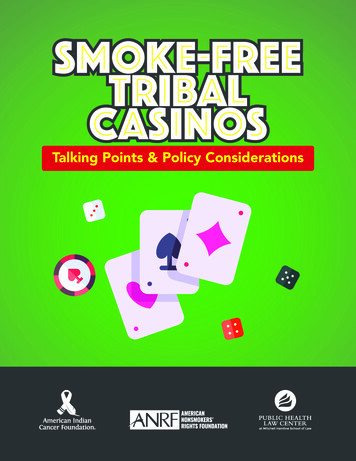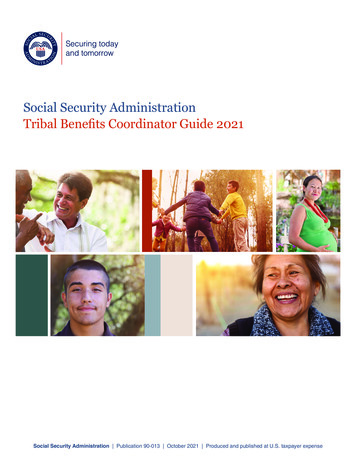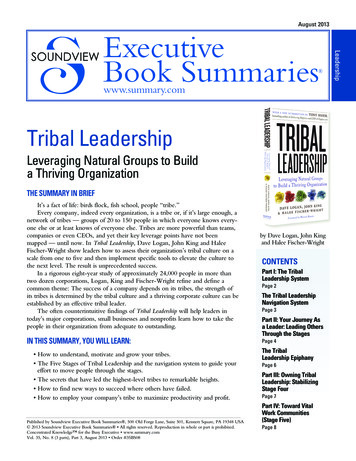
Transcription
August 2013ExecutiveBook Summaries www.summary.comTribal LeadershipLeveraging Natural Groups to Builda Thriving OrganizationTHE SUMMARY IN BRIEFIt’s a fact of life: birds flock, fish school, people “tribe.”Every company, indeed every organization, is a tribe or, if it’s large enough, anetwork of tribes — groups of 20 to 150 people in which everyone knows everyone else or at least knows of everyone else. Tribes are more powerful than teams,companies or even CEOs, and yet their key leverage points have not beenmapped — until now. In Tribal Leadership, Dave Logan, John King and HaleeFischer-Wright show leaders how to assess their organization’s tribal culture on ascale from one to five and then implement specific tools to elevate the culture tothe next level. The result is unprecedented success.In a rigorous eight-year study of approximately 24,000 people in more thantwo dozen corporations, Logan, King and Fischer-Wright refine and define acommon theme: The success of a company depends on its tribes, the strength ofits tribes is determined by the tribal culture and a thriving corporate culture can beestablished by an effective tribal leader.The often counterintuitive findings of Tribal Leadership will help leaders intoday’s major corporations, small businesses and nonprofits learn how to take thepeople in their organization from adequate to outstanding.IN THIS SUMMARY, YOU WILL LEARN: How to understand, motivate and grow your tribes. The Five Stages of Tribal Leadership and the navigation system to guide youreffort to move people through the stages. The secrets that have led the highest-level tribes to remarkable heights. How to find new ways to succeed where others have failed. How to employ your company’s tribe to maximize productivity and profit.Published by Soundview Executive Book Summaries , 500 Old Forge Lane, Suite 501, Kennett Square, PA 19348 USA 2013 Soundview Executive Book Summaries All rights reserved. Reproduction in whole or part is prohibited.Concentrated Knowledge for the Busy Executive www.summary.comVol. 35, No. 8 (3 parts), Part 3, August 2013 Order #35BS08by Dave Logan, John Kingand Halee Fischer-WrightCONTENTSPart I: The TribalLeadership SystemPage 2The Tribal LeadershipNavigation SystemPage 3Part II: Your Journey Asa Leader: Leading OthersThrough the StagesPage 4The TribalLeadership EpiphanyPage 6Part III: Owning TribalLeadership: StabilizingStage FourPage 7Part IV: Toward VitalWork Communities(Stage Five)Page 8LeadershipSOUNDVIEW
THE COMPLETE SUMMARY: TRIBAL LEADERSHIPby Dave Logan, John King and Halee Fischer-WrightThe authors: Dave Logan is co-founder and a former partner of the management-consulting firm CultureSync. John King is cofounder and senior partner of CultureSync. Halee Fischer-Wright is a former CultureSync partner now in private practice as aphysician in Denver.Tribal Leadership: Leveraging Natural Groups to Build a Thriving Organization by Dave Logan, John King and Halee FischerWright. Copyright 2008 by David Logan and John King. Summarized by permission of the publisher, HarperBusiness,HarperCollins Publishers. 303 pages, 16.99, ISBN 978-0-06-125132-0. To purchase this book, go to www.amazon.com orwww.bn.com.Summary copyright 2011 by Soundview Executive Book Summaries , www.summary.com, 1-800-SUMMARY, 1-610-5589495. For additional information on the authors, go to www.summary.com.PART I: THE TRIBAL LEADERSHIP SYSTEMEvery organization is really a set of small towns. Ifyou’re from a small town, think of the people there. Ifyou’re not, think of, as Don Henley sings, “that samesmall town in each of us.”The people are different in every town and the rolesare never exactly the same. But there are more similarities than differences and the metaphor itself alwaysholds, from companies in Nebraska to ones in NewYork or Kuala Lumpur.We call these small towns tribes and they form so naturally it’s as though our tribe is part of our genetic code.Tribes helped humans survive the last ice age, buildfarming communities and, later, cities. Birds flock, fishschool, people “tribe.”are the basic building block of any large human effort,including earning a living. As such, their influence isgreater than that of teams, entire companies and evensuperstar CEOs. They determine how much work getsdone, and of what quality.Some tribes demand excellence from everyone and areconstantly evolving. Others are content to do the minimum to get by. What makes the difference in performance? Tribal Leaders.Tribal Leaders focus their efforts on building the tribeor, more precisely, upgrading the tribal culture. If they aresuccessful, the tribe recognizes them as the leaders, givingthem top effort, cult-like loyalty and a track record ofsuccess. Divisions and companies run by Tribal Leadersset the standard of performance in their industries, fromproductivity and profitability to employee retention. What Is a Tribe?A tribe is a group between 20 and 150 people. Here’sthe test for whether someone is in one of your tribes: Ifyou saw her walking down the street, you’d stop and say“hello.” The members of your tribe are probably programmed into your cell phone and in your e-mailaddress book.Some of the corporate tribes we’ve seen include thehigh-potential managers of one of the world’s largestfinancial services companies; the doctors, nurses andadministrators of one of America’s most respected healthcare institutions; the research and development division ofa mammoth high-tech firm; and the operational executives of a major drug company.Tribes in companies get work done — sometimes a lotof work — but they don’t form because of work. Tribes1-800-SUMMARYThe Five Tribal StagesEvery tribe has a dominant culture, which we can pegon a one-to-five scale, with the goal being stability atStage Four and, on occasion leaps to Stage Five. Allthings being equal, a Five culture will always outperforma Four culture, which will outperform a Three and soon. (Stage Five is unstable but can produce history-making innovation.) People and groups move only one stageat a time and the actions that advance people from StageOne to Stage Two are different from those that advancethem from Two to Three.If tribes are the most powerful vehicles within companies, cultures are their engines. Here is an overview ofthe Five Stages:Published by Soundview Executive Book Summaries (ISSN 0747-2196), 500 Old Forge Lane, Suite 501, Kennett Square,PA 19348 USA, a division of Concentrated Knowledge Corp. Published monthly. Subscriptions starting at 99 per year.service@summary.com Copyright 2011 by Soundview Executive Book Summaries Available formats: Summaries are available in several digital formats. To subscribe, call us at 1-800-SUMMARY (240-912-7513 outside the United States), or order onlineat www.summary.com. Multiple-subscription discounts and corporate site licenses are also available.Rebecca S. Clement, Publisher; Sarah T. Dayton, Editor in Chief; Andrew Clancy, Senior Editor; Amanda Langen, Graphic Designer; Chris Lauer, Contributing Editor2 Soundview Executive Book Summaries www.summary.com
Summary: TRIBAL LEADERSHIPStage OneFortunately, most professionals skip Stage One (onlyabout 2 percent of American professionals operate hereat any given point), which is the mindset that createsstreet gangs and people who come to work with shotguns. If people at Stage One had T-shirts, they wouldread “life sucks,” and what comes out of their mouthssupports this adage. People at this stage are despairinglyhostile, and they band together to get ahead in a violentand unfair world. Most anthropologists say that humansociety started at Stage One — clans scratching out anexistence while fighting with one another.Stage TwoIn 25 percent of workplace tribes, the dominant culture is Stage Two, which is a quantum leap from StageOne. People operating at Stage Two use language centered on “my life sucks.” People in this culture stage arepassively antagonistic; they cross their arms in judgment,but never really get interested enough to spark any passion. Their laughter is quietly sarcastic and resigned. TheStage Two talk is that they’ve seen it all before andwatched it all fail. A person at Stage Two will often tryto protect his or her people from the intrusion of management. The mood that results from Stage Two’stheme, “my life sucks,” is a cluster of apathetic victims.Stage ThreeThe theme of Stage Three, the dominant culture in49 percent of workplace tribes in the U.S., is “I’mgreat.” Or, more fully, “I’m great and you’re not.”Normally, doctors operate at this level on their bestdays, as do professors, attorneys and salespeople. Withinthe Stage Three culture, knowledge is power, so peoplehoard it, from client contacts to gossip about the company. People at Stage Three have to win and for them,winning is personal. They’ll outwork and outthink theircompetitors on an individual basis. The mood thatresults is a collection of “lone warriors,” wanting helpand support and being continually disappointed that others don’t have their ambition or skill.As with Stage Two, no amount of team building willturn this group of self-described star players into a team.Tribal Leadership Up CloseStage 1: Mood: Despairing HostilityTheme: “Life sucks.”Stage 2: Mood: Apathetic VictimTheme: “My life sucks.”Stage 3: Mood: Lone WarriorTheme: “I’m great (and you’re not).”Stage 4: Mood: Tribal PrideTheme: “We’re great (and they’re not).”Stage 5: Mood: Innocent WondermentTheme: “Life is great.”a tribe with a common purpose. They commit to sharedcore values and hold one another accountable. They willnot tolerate The Office-style performance or the personalagenda of Stage Three. Fully three-quarters of tribesoperate below Stage Four, and those in the zone ofTribal Leadership haven’t stabilized at this level. As aresult, they oscillate in and out of Stage Three.Stage FiveStage Four is a launching pad for Stage Five. Whenwe explain this last stage, which reflects less than 2 percent of workplace tribal cultures, we see skeptical lookscoming back at us. Stage Five’s T-shirt would read “lifeis great,” and they haven’t been doing illicit substances.Their language revolves around infinite potential andhow the group is going to make history — not to beat acompetitor, but because doing so will make a globalimpact. This group’s mood is “innocent wonderment,”with people in competition with what’s not possible, notwith another tribe.Teams at Stage Five have produced miraculous innovations. The team that produced the first Macintosh wasat Stage Five and we’ve seen this mood at Amgen. Thisstage is pure leadership, vision and inspiration. After ashort burst of activity, Stage Five teams recede to StageFour to regroup and attend to infrastructure issues beforepossibly returning to Stage Five. In sports, these burstswin Olympic gold medals and Super Bowl rings. Inbusiness, these explosions of leadership make history. Stage FourThe gulf between “I’m great” (Stage Three) and“we’re great” (Stage Four) is huge — Grand Canyonhuge. This level represents 22 percent of workplace tribal cultures, where the theme of people’s communicationis “we’re great.”When groups get to this point, they see themselves asThe Tribal LeadershipNavigation SystemThe key to locating your tribes is to listen for howmost people talk and notice how most people structure theirwork relationships. You’ll see elements of many culturalwww.summary.com Soundview Executive Book Summaries 3
Summary: TRIBAL LEADERSHIPstages in your tribes, so look for what is most common.Signs of Stage One. Most people talk as thoughthey are alienated from organizational concerns. Whenthey cluster together, they form isolated gangs that operate by their own rules, often based on absolute loyalty tothe group. Many people are socially alienated, nevertalking to anyone. The theme of their words is that lifehas given them a bad deal, so it’s OK to do whatever ittakes to survive. There may be acts of violence, such asfistfights or extreme verbal abuse. Minor acts of theft orvandalism are a problem.Signs of Stage Two. People talk as though they aredisconnected from organizational concerns, seeming tonot care about what’s going on. They do the minimumto get by, showing almost no initiative or passion. Theycluster together in groups that encourage passive-aggressive behavior (talking about how to get out of work orhow to shine the boss on) while telling people in chargethat they are on board with organizational initiatives.The theme of their communication is that no amount oftrying or effort will change their circumstances, and giving up is the only enlightened thing to do. From a managerial perspective, nothing seems to work — teambuilding, training, even selective terminations appear todo nothing to change the prevailing mood. The cultureis an endless well of unmet needs, gripes, disappointments and repressed anger.Signs of Stage Three. People engage in anythingthat’s going on with energy and commitment, but,when you listen closely, they talk mostly about themselves, and focus on appearing smarter and better thanothers. They think they’re focused on team concerns,but their actions show their interest is personal. Peopletend to form two-person relationships. They rarely bringpeople together, they resist sharing information exceptwhen it’s necessary and they pride themselves on beingbetter informed than others. Winning is all that matters,and winning is personal. People at this stage complainthat they don’t have enough time or support, and thatthe people around them aren’t as competent or committed as they are.Signs of Stage Four. Teams are the norm, focusedaround shared values and a common purpose.Information moves freely throughout the group.People’s relationships are built on shared values. Theytend to ask, “What’s the next right thing to do?” and tobuild ad hoc partnerships to accomplish what’s important at the moment. Their language focuses on “we,”not “me.” If two people get in a squabble, a third willstep in and repair the relationship rather than create apersonal following for himself. Unlike Stage Two, thegroup is composed of people who have played the StageThree game and won — and who are now ready forgenuine partnerships. Your first job is to make sure eachperson is stable at Stage Four, as most groups at this levelcrash down to Stage Three when under stress.Signs of Stage Five. Your tribes hardly ever refer tothe competition, except to note how remarkable theirown culture is by comparison and how far their resultsoutstrip industry norms. The theme of communication islimitless potential, bounded only by imagination andgroup commitment. People in this culture can find away to work with almost anyone, provided their commitment to values is at the same intensity as their own.(Unlike Stage Four, the focus isn’t on “our values,” buton resonant values.) There is almost no fear, stress orworkplace conflict. People talk as though the world iswatching them, which may well be the case as theirresults are making history. Your job is to make sure theinfrastructure to maintain these leaps to Stage Five isin place. PART II: YOUR JOURNEY AS A LEADER:LEADING OTHERS THROUGH THE STAGESStage One: On the Verge ofa MeltdownThe person at Stage One is alienated from others,expressing the view that “life sucks.”There are two ways to move from Stage One to StageTwo. First, the person has to substitute “life sucks” with“my life sucks” — the mantra of Stage Two. The difference in these stages is huge, and moving forward meansdropping language that the nature of life is flawed andsaying instead that life works for some people, but notfor you.One man we got to know in our research is an artistnamed Joseph. When we interviewed Joseph, he talkedas someone who had made the transition: “I had to giveup my art, because the cost is my family.” He soundedlike a victim of circumstance: that others can do art, butnot him. His life sucked — he’s made it to Stage Two.Second, the person can move to a tribe where theoffending behavior is not tolerated. The mother of aformer gang member, whose son began attending achurch-run youth center, told us, “I’m worried; he usedto be so alive, but now it’s like the cord got pulled.”From a tribal perspective, her son went from the fire ofdespairing hostility (Stage One) to the passivity of being4 Soundview Executive Book Summaries www.summary.com
Summary: TRIBAL LEADERSHIPan apathetic victim (Stage Two). This was progress.When we interviewed him, he looked sad and said,“This place sucks — I don’t know anyone here.” Hehad gone from the alienation of Stage One to the disconnection of Stage Two.Give Stage One People a ChanceThere are people in Stage One who want life to bedifferent, and our advice to employers is to give them achance. William, part of Joseph’s tribe, has made doingso a part of his design and general contracting business,Design For You, in Chicago. He employs former gangmembers, convicts and people who have fallen into (andout of) heavy drug use. He believes that helping peopleout of Stage One is the responsibility of every person insociety. At the same time, if people aren’t willing toleave the allure of Stage One, he doesn’t pursue them. Ifthey relapse into despairing hostility, he invokes the“horse whisperer” protocol and pushes them out, butwatches for when they’re ready to try again. Stage Two: Disconnectedand DisengagedPeople at Stage Two are separate from others,although unlike those at Stage One, they are surroundedby people who seem to have some power that they lack.As a result, their language expresses “my life sucks.”Unlike Stage One, a person at Stage Two communicatesthe view that others’ lives seem to be working.When people at this stage cluster together, theirbehavior shows characteristics of being apathetic victims.Leverage Points for a Person at Stage TwoHere are four leverage points for a person at Stage Two: Encourage her to make a friend. Then anotherfriend. Then another friend. In other words, encourageher to establish dyadic (two-person) relationships. Encourage her to establish relationships with peoplewho are at late Stage Three. Such individuals can beidentified by their eagerness to mentor others intobecoming mini-versions of themselves. In one-on-one sessions, show her how her workdoes make an impact. In particular, show her areaswhere she is competent and where her strengths are. Inthe same meeting, point out abilities she has that she hasnot yet developed, but be careful to make the tone ofthese discussions positive. Assign her projects that she can do well in a shorttime. These assignments should not require excessivefollow-up or nagging, as this behavior may reinforce her“my life sucks” language.Success IndicatorsHere are two indications of success: She will use “I’m great” language, as opposed to“my life sucks.” She may name-drop, point to her ownaccomplishments and brag. Many of her sentences willstart with “I.” She will exhibit the lone warrior spirit of StageThree, often comparing herself with her co-workers andusing disparaging language like “What’s wrong withthem?” and “If they tried, they’d succeed.” Stage Three: The Wild, Wild WestThe essence of Stage Three is “I’m great.” Unstatedand lurking in the background is “and you’re not.” Askpeople at this stage how they see work and you willhear: “I’m good at my job,” “I try harder than most,”“I’m more able than most,” and “Most people can’tmatch my work ethic.” The key words are “I,” “me”and “my.”People at Stage Three report, almost universally, thatthey don’t have enough time, don’t get enough support,and are surrounded by people less able and dedicatedthan they are. No matter how hard they work, theycan’t punch through the barrier of a day that has only 24hours. They’ve hit the point of diminishing returns, sothe harder they work, the less effective they are and theless their efforts seem to matter. Simply put, they wantto get to the next level but don’t know how to getthere or even what the next level looks like.Leverage Points for a Person at Stage ThreeHere are eight leverage points for a person atStage Three: Encourage him to work on projects that are biggerthan anything he can do alone. In short, assign himwork that requires partnership. Point out that his success has come through his ownefforts, but that the next level of success is going torequire a totally different style. In other words, showhim that what’s brought him to this point will not beenough to move him forward. Describe role models (ideally in the company) thatare exhibiting Stage Four behavior. You’ll know theseindividuals by (1) their focus on “we,” (2) the numberof triads (three-person relationships) in their networksand (3) success that comes from groups. When the person complains that he doesn’t havetime and that others aren’t as good (the two chief gripesat Stage Three), show that he has crafted his work life sowww.summary.com Soundview Executive Book Summaries 5
Summary: TRIBAL LEADERSHIPthat no one can really contribute to him. Tell stories about the time you made the transitionfrom Stage Three to Stage Four. Coach him that real power comes not from knowledge, but from networks and that there is more leveragein wisdom than in information. Encourage him to manage using transparency, asmuch as is possible under corporate policy. Encourage him to form triads. The Tribal Leadership EpiphanyHaving interviewed thousands of people who havemade it into Stage Four, the zone of Tribal Leadership,we discovered that every person had an awakening.Some called it a major business insight. One said, “Inthe shower this morning, I realized there’s a better wayto do business that will mean much higher profitability.”Some called it corporate karma. Others described it as aneed to live their values. Some came to it after years ofpsychotherapy or doing a self-help program. Some cameto it through what Warren Bennis and Robert Thomas(in Geeks and Geezers) call a crucible experience: anevent that causes people to reflect — at both intellectualand emotional levels — on their core assumptions. Forsome people, 9/11 kick started the epiphany. For mostpeople, the epiphany was actually a series of epiphanies,each presenting a deeper insight about what wasn’tworking in Stage Three.While the epiphany happens to all Tribal Leaders, itmay not happen in adulthood. Gordon Binder, formerCEO of Amgen, apparently had it growing up in NewMexico and finished it in the Navy. Frank Jordanbecame a Tribal Leader through the Boys & Girls Clubs.They described the epiphany as the turning point intheir lives, both personally and professionally, regardlessof how they came to it or went through it.Although it often took months or years for theepiphany to burble through their minds, once themoment of awareness happened, there was no turningback. They often described it in sound bites. We heardstatements like: Nothing that matters is personal. Stage Three has no legacy. To win at Stage Three is to win small. I now see I have been a manipulator, not a leader. I’m tired; isn’t there some other game to play? I see myself through others’ eyes and I don’t likewhat I see.As the person sees into her blind spots she realizes thatthe ego hit of accomplishment isn’t the same as successitself. Her attention shifts to what’s really important,and, almost always, the goal is tribal. David Kelley,CEO of IDEO, said his goal became “Hanging out withgreat people and creating stuff that makes a difference.”George Zimmer, CEO of Men’s Wearhouse, said, “Weneed to keep thinking about the people in our storesand how to make their lives better.”As the seesaw tilts toward Stage Four, the person’s language and behavior shift away from dyadic relationshipstoward networked systems of people. Stage Four: EstablishingTribal LeadershipIn our research, after a person has had the epiphanythat takes him from Stage Three to Stage Four, hebehaves differently. Our data show that people tend totake one of three paths. Kelley, took the first: He gottogether a group of like-minded friends and asked howthey might make money. The relationships come beforethe business model; the tribe before the profits. If thegroup is composed of people who are really operating atStage Four (rather than dropouts from the system in themidst of Stage Two), the ventures tended to do verywell, like IDEO. The key question is, “Have we allowned and are we all done with Stage Three?” If theanswer is yes, a small group of people becomes what wecall a tribal seed. As it grows, it attracts resources, people, money and ideas, and it flourishes into a tribe.The second path is that the newly minted Stage Fourperson looks for people in a large organization who areeager to play by a different set of rules. Often, these willbe people in late Stage Three or individuals in theprocess of going through the epiphany. The TribalLeader collects and nurtures them and forms a tribebased on their values and aspirations. The group —often a new department or, in a matrix organization, a“project” — becomes unusually successful, often beinglabeled a “miracle.” As the group succeeds, people atStage Three notice the results, often trying to replicatethe tribe’s strategy within an “I’m great” culture. Suchapproaches fail, and the Tribal Leader’s group movesfurther ahead with people scratching their heads abouthow he does it.The third path is that the person forges out on herown, developing what we call tribal antennae — anintuitive ability to find people who can contribute tosuccess on a larger scale than one person working alone6 Soundview Executive Book Summaries www.summary.com
Summary: TRIBAL LEADERSHIPand who value her help in return. From the outside, heractions look like networking gone wild — she’s constantly reaching out to more and more people, with others saying that she needs to learn focus. In fact, heractions are systematic: She is shopping for tribal members. As she finds people who fit, she networks theminto the group, and a tribe slowly takes shape. Unlikethe first approach, where the tribal seed determines thenature of the business from the start, this third path produces rapidly changing tribes and business models. Thekey to this third path is that it’s not “my tribe,” but“our tribe.” The person who cobbled it together is recognized as the Tribal Leader, not the single visionarywho calls the shots. In this system, anyone is welcome toplay — and tribal members all have a hand in recruiting,provided they have something to offer and obeythe rules. PART III: OWNING TRIBAL LEADERSHIP:STABILIZING STAGE FOURA key point for companies that want to attain StageFour is to go for values now.Core values are “principles without which life wouldn’t be worth living.” There are two ways to seek corevalues. The first is for a Tribal Leader to tell a valueladen story, which triggers others to tell similar storiesabout their values.The second way is to ask three to five open-endedquestions such as, “What are you proud of?”The Tribal Leader’s goal is to find shared values thatunite the tribe.A Noble Cause Is What We ‘Shoot For’If core values are the fuel of a tribe, a noble cause isthe direction it’s headed. A noble cause captures thetribe’s ultimate aspiration. Said differently, core valuesare what we “stand in” and a noble cause is what we“shoot for.”There are two ways to find a tribe’s noble cause. Thefirst is to keep asking, “in service of what?”The second way is to ask the Big Four Questions ofpeople in the tribe: “What’s working well?” “What’snot working?” “What can we do to make the thingsthat aren’t working, work?” and “Is there anythingelse?” These questions capture a group’s current assessment of its situation and its aspirations about whatshould change and why. The noble cause will oftenemerge out of people’s answers to the questions.The goal of determining values and a noble cause isn’tagreement; it is alignment, which produces coordinatedaction married with passionate resolve. Anything notconsistent with the core values and noble cause needs tobe reworked or pruned.The group captures the essence of Tribal Leadershipwhen it asks, “What activities will express our valuesand reach toward our noble cause?” The answerbecomes a reason to form networked relationships andthe basis of a tribal strategy. Triads and Stage Four NetworkingEvery September, a remarkable party takes place atwhich people in commercial real estate discuss and closemore business than perhaps on any other night of theyear. At the center of the party is CB Richard Ellis ViceChair, Darla Longo.Longo’s behavior was the most remarkable part of theevent and most missed her magic. She didn’t promoteherself, talk about her accomplishments or say “I,” “me”or “my,” other than to say, “I’d like you to meet .”Longo played matchmaker. She introduced clients tobrokers, senior brokers to successful rookies and clientsto one another.If we were to take any moment of the evening andwatch it in slow motion, we’d see three elements. First,Longo would have at least two people around her.Second, she would talk to them both at the same time,even if they didn’t know each other. Third, if we listened to her words, we’d notice that they would havethe effect of building or deepening the relationshipbetween the other two people.Longo emerged as one of the leaders in commercialreal estate for many reasons: her drive, endless energy,talent, vision for the business, and focus on integrity andvalues. In our years of watching her, one simple act ofbehavior stands out: her ability to “triad” — to createbusiness relationships between two people, based on corevalues and mutual self-interest, and then move on. Inessence, she receives loyalty and followership by creatingrelationships between other people. She is one of themost successful people in commercial real estate becauseher actions build triads, the foundation of a Stage Four
The Tribal Leadership Navigation System The key to locating your tribes is to listen for how most people talk and notice how most people structure their work relationships. You'll see elements of many cultural Summary: TRIBAL LEADERSHIP www.summary.com Soundview Executive Book Summaries 3 Tribal Leadership Up Close Stage 1: Mood .


